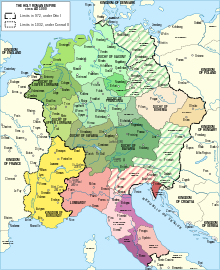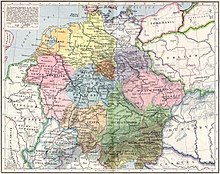利用者:ぎぶそん/下書き1
 |
ここはぎぶそんさんの利用者サンドボックスです。編集を試したり下書きを置いておいたりするための場所であり、百科事典の記事ではありません。ただし、公開の場ですので、許諾されていない文章の転載はご遠慮ください。
登録利用者は自分用の利用者サンドボックスを作成できます(サンドボックスを作成する、解説)。 この利用者の下書き:User:ぎぶそん/sandboxlist=User:ぎぶそん/下書き1・User:ぎぶそん/下書き2・User:ぎぶそん/下書き3・User:ぎぶそん/下書き4・User:ぎぶそん/下書き5 その他のサンドボックス: 共用サンドボックス | モジュールサンドボックス 記事がある程度できあがったら、編集方針を確認して、新規ページを作成しましょう。 |

The Stem duchies (ドイツ語: Stammesherzogtümer, from Stamm, literally "tribe") were essentially the domains of the old Germanic tribes of the area associated with the Francia, especially the Eastern part upon the 843 partition by the Treaty of Verdun, in the Early Middle Ages.
Eventually, when East Francia began to transform into the Holy Roman Empire,[1] the old tribal areas assumed new identities as the subdivisions of the realm, joining Lotharingia (properly Middle Francia).[2] In contrast to later duchies, these entities were not defined by strict administrative boundaries but by the area of settlement of major Germanic tribes. Their dukes were neither royal administrators nor territorial lords.
Tribes that became stem duchies were originally the Alemanni, the Thuringii, the Saxons, the Franks, the Burgundians, and the Rugii.[3] In the 5th century, the Völkerwanderung (or Germanic migrations) brought a number of tribes into the failing Roman Empire. In 443 and 458, the Burgundians moved to settle in the Kingdom of Burgundy; the area they had formerly occupied in Germania was then occupied by the Franks. The Franks were a fusion of West Germanic tribes whose leaders had long been aligned with Rome. The Rugii were destroyed in the wars over Italy in the 5th and 6th centuries, and a new confederation of Germanic peoples formed in their place: the Bavarii. All these tribes in Germania were eventually subjugated by the Franks;[4] the Alemanni fell in 496 and 505, the Thuringii in 531, the Bavarians at some point after 553, and then finally the Saxons by 804 in a protracted campaign by Charlemagne himself.[2]
Other entities started to evolve their respective identities.[5] The Czechs' domain of Bohemia under the ruling Přemyslid dynasty, which accepted Imperial suzerainty as a duchy by 925, later upgraded to a kingdom in 1158. North and south of Bohemia, the Germans headed east, founding a series of border counties or Marches, ruled by margraves (mark-graf). To the north these started with the Margraviate of Meissen and the March of Lusatia, and to their north the Northern March, which became the Margraviate of Brandenburg (the heart of the later Kingdom of Prussia). Last in the north was originally the Billung March, which eventually became the duchies of Holstein, Lauenburg, Mecklenburg, and Hither Pomerania. In the south, there were the marches of Carniola, Carinthia, Styria, and Austria (later Österreich ("eastern realm") or Duchy of Austria). The Kingdom of Prussia and the Archduchy of Austria, which became some of the most powerful European states, thus began as marches.[2]
Remnants of several stem duchies survive today as states or regions in modern Western Europe countries. The Saxon, Bavariian, and Thuringian, territories became the German states of Saxony, Bavaria, and Thuringia; the Frankish and Alamannian territories became the German regions of Franconia and Swabia. Part of the Burgundians' territory became the modern-day French administrative région of Burgundy, and Lotharingia became the région of Lorraine.[2]
「旧」部族大公領
[編集]
The older stem duchies were regions inhabited by Germanic tribes that were associated with the Frankish Kingdom[要出典]. The duchies were more or less independent entities ruled by native rulers who had acquired the title of herzog (equivalent to "duke"). All of them came to an end during the rule of the early Carolingians. These older stem duchies were:
- アラマンニア(シュヴァーベン)
- The Alamanns came under Frankish supremacy around 539 and were ruled by various dukes until 746, when the Frankish mayor Carloman terminated the duchy in the Blood court at Cannstatt.
- バイエルン
- The Bavarians came under Frankish supremacy around 550 and were ruled by the Agilolfings until 788, when Charlemagne deposed the last Duke.
- ザクセン
- The Saxons were loosely associated with the Merovingian Kingdom but practically remained independent until they were subdued by Charlemagne in the Saxon Wars (772–804).
Some tribes, such as the Frisians, never formed a stem duchy with cultural allegiance to any single duke.
Herzog is not related to Herz ('heart'), but is derived from German(ic) He(e)r ('army') and zog (ziehen) (English: 'to pull, drag', also in die Schlacht ziehen - "to go into battle"), a military leader. It may have originated from the Proto-Germanic title of Harjanaz, who were elected by their tribes to lead them into battle. Thus Herzog was a title borne by Germanic warriors who exercised military authority over a tribe by general acclaim among its members or warriors,[6] especially in the stem duchies. During the medieval era, some of the most powerful vassals whose territories lay within the boundaries of the Holy Roman Empire took or were granted the title of Herzog by the Emperor. Several dynasties, such as the Habsburgs of Austria, Hohenzollerns of Prussia, Welfs of Hanover, Wettins of Saxony, Wittelsbachs of Bavaria and the House of Württemberg, held the Herzogswürde (dukedom) before becoming kings.
「新」部族大公領
[編集]
ザクセン大公(黄色)、フランケン大公(青色)、バイエルン大公(緑色)、シュヴァーベン大公(薄橙色)、ロタリンギア大公(ピンク)。
After the demise of the stem duchies, the Carolingians administered these regions through counts and prefects or sometimes distributed the rule to a member of the dynasty, e.g., Louis the German in Bavaria. After the division of the Kingdom in the Treaties of Verdun (843), Meerssen (870), and Ribemont (880), the Eastern Frankish Kingdom or East Francia was formed out of Bavaria, Alemannia, and Saxony together with Eastern parts of the Frankish territory. The kingdom was divided in 864–865 among the sons of Louis the German, largely along the lines of the tribes. Royal power quickly disintegrated after 899 under the rule of Louis the Child, which allowed local magnates to revive the duchies as autonomous entities and rule their tribes under the supreme authority of the King. After the eastern branch of the Carolingians died out (911) the dukes competed for the crown, with first the Franconian Conradines (911) and eventually the Saxon Liudolfings (919) winning out. Though their and their successors' strong government often reduced the dukes to royal lieutenants again, the stem duchies largely remained intact until the reign of the Hohenstaufen dynasty.
The younger stem duchies were[要出典]:
- ザクセン大公 (880年–1180年)
- The Liudolfing family, which had long been employed in the administration of Saxony, rose to the position of Dukes and even attained the Kingship after 919. In the 11th century, the Duchy was ruled by the Billungs, After 1137 the House of Welf dominated the duchy. The fall of Duke Henry the Lion in 1180 resulted in the dismantling of the stem duchy, into three smaller parts: the (Duchy of Westphalia, the Duchy of Brunswick-Lüneburg, and the Duchy of Saxony on the river Elbe).
- フランケン大公 (906年–939年)
- The Conradine family, close to the royal court, obtained ducal hegemony in Franconia but never managed to unify the region. After attaining the Kingship in 911, they had to yield the crown to the Saxon Liudolfings. After a failed rebellion, the Conradines were deposed and the Duchy made into a land of the crown. The region fragmented into a conglomerate of noble territories and ecclesiastical principalities.
- バイエルン大公 (907年–1180年)
- The Luitpolding family, responsible for the defense of the March of Carinthia, rose to the position of Dukes. They were succeeded by a branch of the Liudolfing dynasty and eventually the Welfs, whose struggle with the Hohenstaufen Kings resulted in Bavaria being stripped of Austria (1156), Styria and Tyrol (1180). The reduced territorial duchy was given to the Wittelsbach family.
- シュヴァーベン大公 (909年–1268年)
- The Thurgau-based Hunfridings first rose to the position of Dukes but soon lost the rule in their struggle with the Liudolfing kings. After various families, the Duchy passed to the Hohenstaufen family in 1079. Their rise to the Kingship made Swabia a base of the crown but their fall in the 13th century left Swabia in complete disintegration, with remains falling to the Wittelsbach, Württemberg, and Habsburg families.
- ロタリンギア大公 (903年–959年)
- As a central component of the Frankish kingdom and with an essentially Frankish tribal identity, Lotharingia was organized as a Duchy in 903 and kept a changing position between the Eastern and the Western Kingdom until 939, when it was firmly incorporated into the Eastern Kingdom. In 959 the Duchy was divided into Lower Lotharingia (which in turn fragmented further) and Upper Lotharingia (parts of which developed into the French territory called Lorraine).
フランスの部族大公
[編集]German historians have commonly restricted the term "stem duchy" to the Eastern kingdom with its variety of Germanic tribes, in contrast to the romanized and more unified Western kingdom, whose duchies were considered regional units of administration without ethnic cohesion. However, according to Flach[7] and Kienast,[8] the duchies of France (Brittany, Normandy, Gascony, Aquitaine, and Burgundy) also had an ethnic basis before the French kings began creating dukes in the 14th century. The nature and role of Germanic stem duchies are now often characterized by contrasting them with the oldest duchies of Francia.[8]
The twelve paladins of Charlemagne are said to have inspired the creation of twelve ancient pairies (peers) in France: six temporal geographical units (Normandy, Burgundy, Aquitaine, Flanders, Toulouse, and Champagne) plus six ecclesiastic geographical units (Noyon, Rheims, Laon, Langres, Beauvais, and Châlons).[9] This system was imported to the Crusader states, as the custom was known and prevalent among the Franks.
Footnotes
[編集]- ^ “FRANCIA, the Franks, France, Burgundy, Italy, Germany”. Friesian.com. 2012年10月1日閲覧。
- ^ a b c d “Germany, the Stem Duchies & Marches”. Friesian.com (1945年2月13日). 2012年10月26日閲覧。
- ^ "Germany". Encyclopædia Britannica. Encyclopædia Britannica Online. Encyclopædia Britannica Inc., 2012. Web. 12 Sep. 2012 <http://www.britannica.com/EBchecked/topic/231186/Germany/58091/Rise-of-the-duchies>
- ^ Goffart, Walter A. (1988). The narrators of barbarian history (A.D. 550–800): Jordanes, Gregory of Tours, Bede, and Paul the Deacon. Princeton University Press
- ^ “Germany, the Stem Duchies & Marches”. Friesian.com (1945年2月13日). 2012年10月1日閲覧。
- ^ Pine, L.G.. Titles: How the King became His Majesty. "Titles in Western Europe." Barnes & Noble, Inc. 1992, pp. 70-73. ISBN 1-56619-085-1
- ^ J. Flach, Origines de l'ancienne France.
- ^ a b W. Kienast, Der Herzogstitel in Frankreich und Deutschland (9. bis 12. Jahrhundert. 1968.
- ^ Arnaud Bunel. “Duchés et Pairies français”. Heraldique-europeenne.org. 2012年10月1日閲覧。
